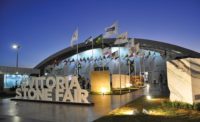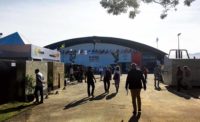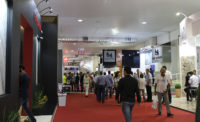The 2019 edition of the Vitoria Stone Fair/Marmomac Latin America brought together more than 15,000 visitors and 300 exhibitors from around the world to promote the overall industry and the products that it offers. Recently celebrating its 47th anniversary, show management continually works to develop new ideas for new programs and exhibits to offer visitors. This year, stone trends was a primary focus of the international stone exhibition, which was held from February 12th to 15th at Carapina Exhibition Park in Espírito Santo, Brazil.
Milanez & Milaneze reported that attendees not only came from Brazilian states but also 51 countries. And in addition to Brazilian exhibitors, eight other countries were represented among the exhibitors. In addition, through the Buyers Club Program, the fair brought more than 100 international importers in order to boost the export of ornamental stones.
Show attractions
With intentions of concentrating on the newest stone varieties that are available on the market and their design potential, a highlight of the Vitoria Stone Fair this year was the “Stone Collection” exhibit that took place along with the Brazilian Stones Original Design exhibit. According to show management, Milanez & Milaneze, this area provided the opportunity for visitors to appreciate, in one place, the trends in stone and their design possibilities.
The Stone Collection exhibit was the result of a partnership with the Brazilian Association of the Ornamental Stones Industry (Abirochas) and Brazilian Agency for the Promotion of Exports and Investments (Apex-Brasil). In total, 11 companies from the region of Espírito Santo displayed their products. Among the products was Zanet White quartzite from Monte Sião group, which will be used in the UVV Highline project — an educational institution that will be built at Enseada do Suá in Vitória. Additionally, Margramar officially launched its semiprecious stone “Jade.” The material is composed of several types of semiprecious stones and perfectly suitable for kitchen countertops, bathroom vanities and showers, flooring and wall panels. Guidoni Group showcased its new exclusive Milky Way granite, an exotic material that has already been specified for the new Istanbul International Airport in Turkey.
Other luxurious and exclusive stone varieties on display in the Stone Collection included Venaria Reale quartzite, recently discovered by the PBA Stones; Riviera granite and Marrakesh marble from the Qualitá Group; Brasigran´s Yosemite Falls; Venon, Ocean Blue and Santorini Cross Cut from Cajugram; Mag Ban´s Blue Moon, Blue Velvet and Avocatus; and Gaya quartzite from Marbrasa.
This was the second edition of the Brazilian Stones Original Design exhibition, which featured stone elements such as tables, countertops and fruit trees that were created by 16 renowned Brazilian designers and artists. From the exhibition, these pieces will be exhibited in other countries or put up for sale.
“Design and art are the best ways to add value to the stone sector and present all lightness and versatility a stone can acquire,” said Vivian Coser, architect and curator of the Brazilian Stones Original Design. Currently, Espírito Santo is the largest exporter of slabs and blocks of marble and granite in the country, accounting for more than 80% of Brazilian production. The intention of the exhibition, according to Coser, is to show that it is possible to transform materials into pieces of design and works of art, bringing more value and attracting new export markets.
At the opening of the Brazilian Stones Original Design exhibition, the president of Abirochas, Reinaldo Dantas Sampaio, reinforced that the stone sector undergoes a “third wave in exports.” “First were the blocks, then the sawn and polished slabs — placing Brazil as the fourth player in the world,” he explained. “And now, we want to conquer the final product market — the work, the project, adding value and sophistication.”
Coser pointed out that this new take on the stone industry brings a new approach to originality, beauty and authenticity. “The stone is authentic and I look at the materials that try to imitate it in a vain attempt to gain an authenticity that only the stone has,” she said.
Sampaio also said that the maturity of the Brazilian entrepreneur and the technological quality of the industry makes clear that the segment is ready for this new market achievement, exemplifying the actions developed by Abirochas within the Vitoria Stone Fair as the approach of international architects with Brazilian industrialists.
Promoting international business
The Vitoria Stone Fair once again offered its Buyers’ Club project, which promotes international business opportunities and enables the arrival of foreign buyers from strategic markets for the exhibition. New this year was the “Business Rounds,” which arranged appointments between producers and international buyers. The meetings, consisting of short sessions to present a portfolio of material, were developed to broaden the approach between stone exhibitors with distributors, builders and architecture firms in the international market.
Cecília Milaneze, director of Milanez & Milaneze, said that buyers who visit Vitoria Stone Fair/Marmomac Latin America are decision makers. Attendees are made up of distributors, as well as industry professionals from warehouses, large marble mills, mining companies, equipment rental companies and construction companies. Additionally, there will be a number of architects and designers.
With an eye on the possibilities of using natural stone and the emergence of technologies destined for finishes and new textures, a group of American architects, invited by Abirochas, confirmed presence at Vitoria Stone Fair. The U.S. is currently the main destination of Brazilian stones — accounting for almost 60% of total export turnover.
The president of Sindirochas, Tales Machado, highlighted the importance of the international stone exhibition as a support tool for the development of the productive chains of the stone industry. “Vitoria Stone Fair is an established and successful event and its positive impact on the economic and social development of the sector and on the economy of Espirito Santo, with the development of new businesses, is recognized,” he said. “The return of the fair to February, its original month, was important to keep the fair as a first offer in the world market. A new concept in the stand´s presentation, with a bigger focus on the applicability of the stones brought to the environment more beauty and warmth, aligned with the richness of details and carefulness in its conception. This year, once again, there were releases of several materials, about 40, reassuring the geological diversity of Brazil. Expectations for next year are big.”












